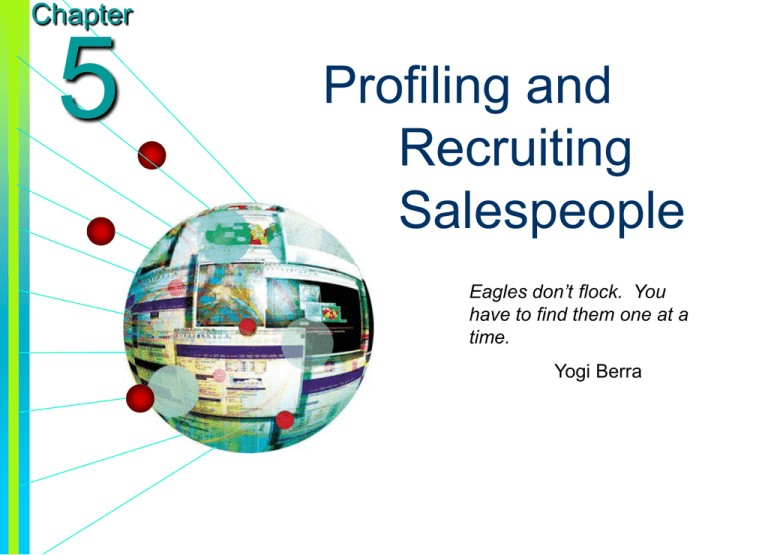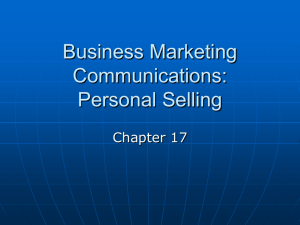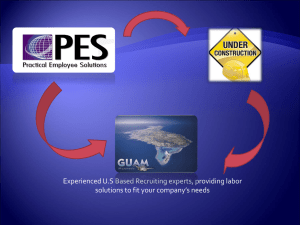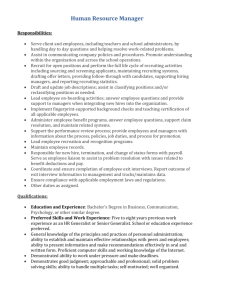
Chapter
5
Profiling and
Recruiting
Salespeople
Eagles don’t flock. You
have to find them one at a
time.
Yogi Berra
Copyright © 2003 by The McGraw-Hill Companies, Inc. All rights reserved.
Recruiting and Selection Problems
Lack
of resources
Lack
of job specification and
qualifications
Qualifications
Lack
not objectively established
of managerial training
Personal
Search
prejudices
for managerial talent
Copyright © 2003 by The McGraw-Hill Companies, Inc. All rights reserved.
Key Laws and Regulations
Affecting a Sales Force
Civil Rights Act of 1964
Federal Contract Compliance, Executive Orders
Age Discrimination in Employment Act (1967)
Fair Employment Opportunity Act (1972)
Rehabilitatin Act of 1973
Vietnam Era Veterans Readjustment Act (1974)
Uniform Guidelines on Employment Selection Procedures
(1978)
Americans with Disabilities Act (1990)
Copyright © 2003 by The McGraw-Hill Companies, Inc. All rights reserved.
Fig. 5-2 Sales Force Staffing Process: Plan for Recruiting & Selection
Establish Responsibility
for Recruiting, Selection
and Assimilation
Determine
Number of
People Wanted
Conduct Job
Analysis
Prepare Job
Description
Determine Hiring
Qualifications
Recruit Applicants
Select Applicants
Design a System
For Measuring
Applicants
Measure Applicants
Against Hiring
Qualifications
Make Selection
Decisions
Hire The People
Assimilate New People Into Sales Force
Copyright © 2003 by The McGraw-Hill Companies, Inc. All rights reserved.
Workload Analysis
Number of reps needed =
Market workload:
Customer
class
A
B
Total workload in market
Workload one rep can handle
Number of
x
accounts
400
600
Calls
Total
=
per year
calls
20
8,000
10
6,000
14,000
One rep’s workload:
Calls/day x Selling days/week x Working weeks/year = Annual workload
5
x
5
x
50
=
14,000
Number of reps needed =
1250
=
Copyright © 2003 by The McGraw-Hill Companies, Inc. All rights reserved.
112 reps
1250
Fig 5-3 Determining the Number of
Salespeople Needed
Strategic Plans
-
New
Eliminated/ + Promo- + Retirements + Terminations/ = Total new
territories combined
tions
resignations reps needed
territories
Expansion MN and RI
into Texas. Territories
4
-
1
2 promo
expected
+
2
2 retirements
expected
+
Copyright © 2003 by The McGraw-Hill Companies, Inc. All rights reserved.
2
1 termination
expected
+
1
New reps
needed
=
8
Content of Job Description
• Title
• The nature of the product or service to be sold
• Type of customers to be called on,
frequency of calls, and types of personnel to be contacted
• Specific tasks and responsibilities to be
carried out
• Organizational relationships
• Mental and physical demands of the job
• Environmental pressures and constraints
that might affect the job
Copyright © 2003 by The McGraw-Hill Companies, Inc. All rights reserved.
Fig. 5-4
Ten traits and abilities of top salespeople
Trait
Related Ability
Ego strength
To handle rejection
Sense of urgency
To complete the sale
Ego drive
To persuade people
Assertiveness
To be firm in negotiations
Willingness to take risks
To be innovative
Sociability
To build relationships
Abstract reasoning
To sell ideas
Sense of skepticism
To question, to be alert
Creativity
To sell complex products and ideas
Empathy
To understand customer needs
Source: Erika Rasmusson, “The 10 Traits of Top Salespeople, “ Sales & Marketing Management, August
1999, pp. 34-37.
Copyright © 2003 by The McGraw-Hill Companies, Inc. All rights reserved.
Recruiting for the Team
• Willingness to share
• Cooperative
• Trusting
• Empathetic
• Accepting of others
• Receptive to others ideas
• Selflessness
• Leadership skills
Copyright © 2003 by The McGraw-Hill Companies, Inc. All rights reserved.
Recruiting Sources of Sales Reps
Source
Comment
Referrals:
Candidates and position are known to person making referral. Existing
sales force is an excellent source for referrals as they know their job
requirements and can identify good matches.
Current employees
Company employees know the company and its products.
Other Companies:
Competitors
Competitors know the customers and are familiar with your products.
Customers
Customers know your products and your company.
Suppliers
Suppliers know your company and your products.
The Internet
Recruits may come through the company’s own website – or through
specialized Internet recruiting sites, such as Monster.com.
Educational institutions
Primarily used when recruiting inexperienced people. Students are
usually actively involved in a job search, and this provides an efficient
place to screen large numbers of available candidates.
Advertisements
Produces the greatest number of candidates, but the average
quality is sometimes lower.
Employment agencies
The agency is often more costly than other methods, but it will
do a large part of the initial screening.
Part-time workers
These workers are easy to contact, readily available, and can
work flexible hours. This is a good source for in-home selling.
Voluntary applicants
These applicants are interested in your firm and probably possess
a high degree of self-confidence, self-reliance, and initiative.
Copyright © 2003 by The McGraw-Hill Companies, Inc. All rights reserved.
Fig. 5-8 Recruiting Evaluation Matrix
Evaluation Criteria
Consistent
with
strategic
Number
planning? recruits
Recruiting
sources
Within company:
Sales force
departments
Number
hired
Other
Other companies:
Competitors
Customers
Noncompetitors
Educational institutions
Advertisements
Employment agencies
Voluntary applicants
Computerized databases
Copyright © 2003 by The McGraw-Hill Companies, Inc. All rights reserved.
Percent
retained
after 3
Cost
years
Rep’s perFrequency formance
after 2 yrs.
of use






